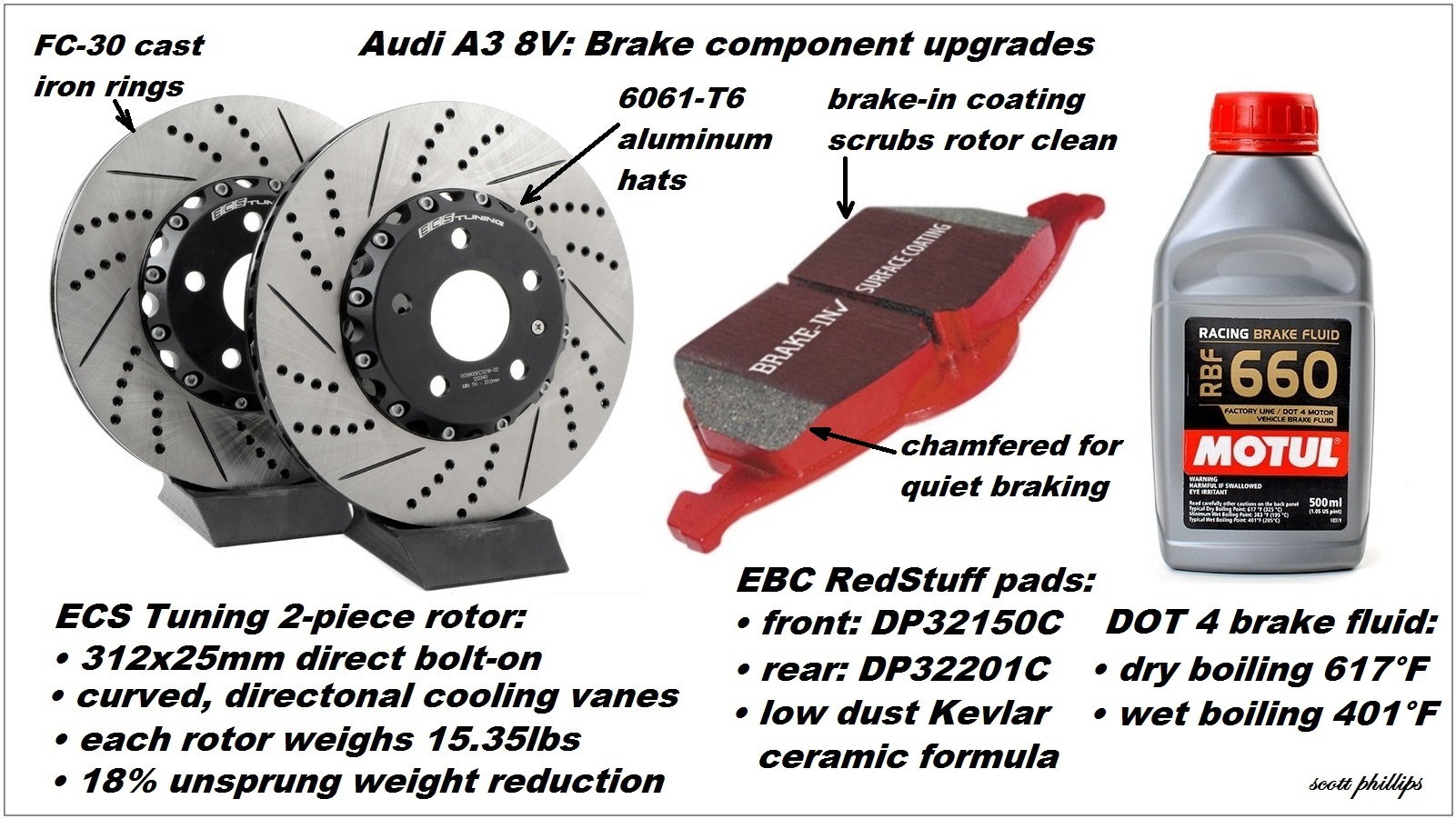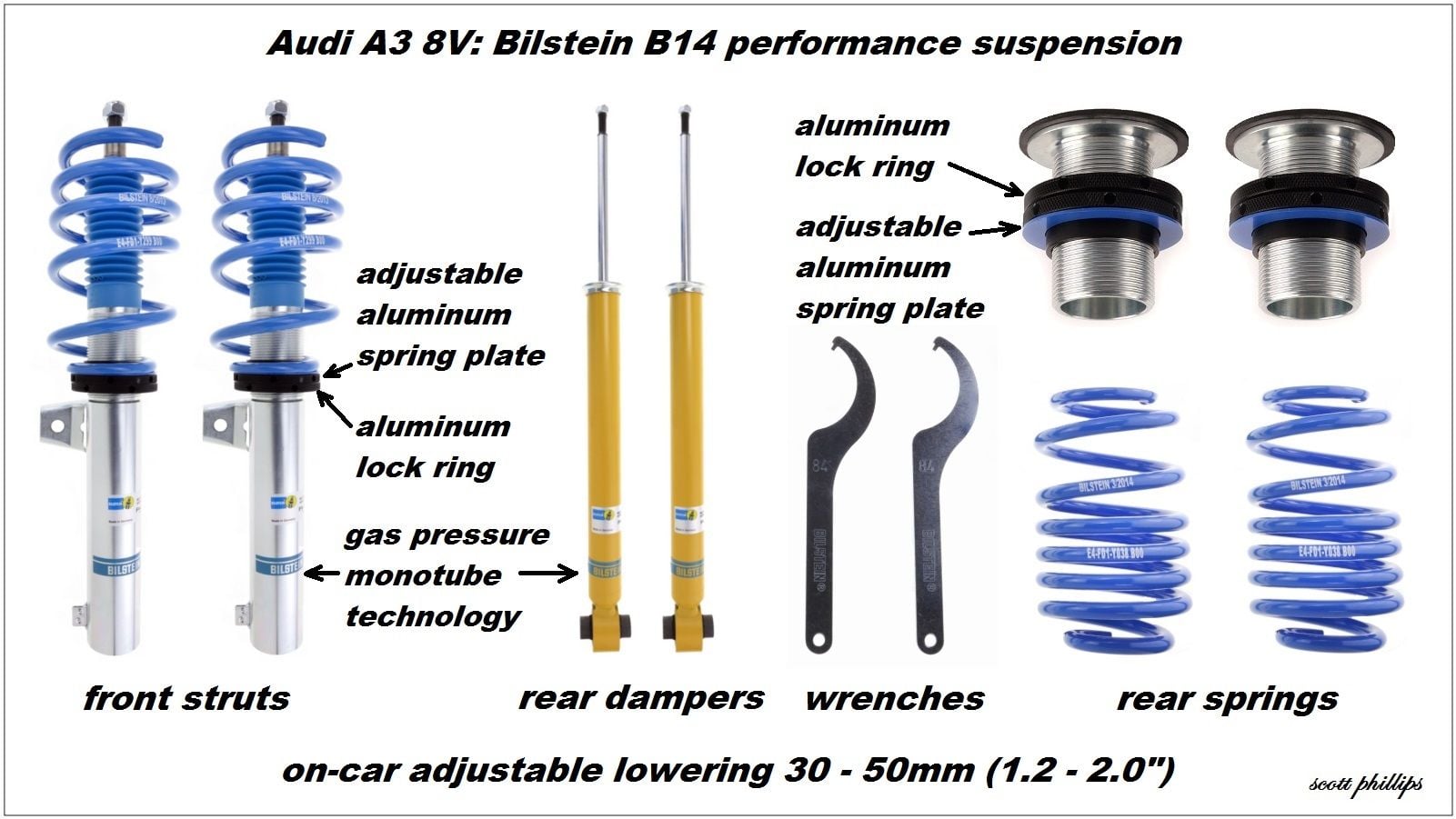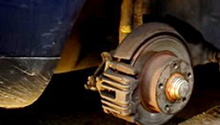Audi A3: Top Modifications
Read on for cost effective, top performance mods that you can do with common tools and a bit of mechanical skill.
This article applies to the Audi A3 8V (2012-Present).
Your Audi A3 is a premium sport sedan designed for the discriminating driver, but there are still several cost effective ways to enhance the performance potential of this excellent platform. For a better appreciation of performance modifications, consider the effect of unsprung weight:
- Sprung Weight: The frame and body of the A3, and everything in it, that is riding on the suspension springs.
- Unsprung Weight: The parts of the A3 suspension that are not supported by the springs. This includes the drive axles, brakes, wheels and tires. Unsprung weight has inertia that resists changing direction, such as suspension motions and quick steering transitions. The brake rotors, wheels and tires are rotating unsprung weight, that sap engine and brake performance in the effort to spin them faster and slower. As a general rule, adding one pound of unsprung weight has the performance effect of adding seven pounds of load, with rotating unsprung weight being the most detrimental.
Top Mods Component Breakdown
High Performance Brake Rotors, Pads and Fluid

DIY Cost – $770
Professional Cost –$1,300
Skill Level – Moderate; requires jacking the A3 and knowledge of brake system assembly.
Your A3 is equipped with 12.3" vented front rotors and 10.7" solid rear rotors. Single-piston calipers provide clamping force at all four wheels. Total unsprung weight of the upgradable brake parts is 33.3 lbs at each front wheel and 17.2 lbs at each rear wheel. Basic upgrading of the rear brakes is limited to using high performance pads, because of the integral electromechanical parking brakes mounted on both rear calipers. The components pictured below are for an A3 Quattro Premium Plus.
Big brake kits increase braking authority by using a larger rotor and a multi-piston caliper, so that the clamping action of the caliper is acting on a longer moment arm. With a larger rotor, the caliper is mounted farther from the hub and has more mechanical advantage. (Consider the mechanical advantage of the tiny calipers on a bicycle wheel rim.) Additionally, the rotor's greater mass can absorb and release more heat, for cooler running. The trade-off is that the larger rotor and heavier caliper increase unsprung weight. A big brake kit saps performance to overcome its own inertia. Aaargh!
Conversely, the best way to improve your A3's performance is to reduce unsprung weight with lighter front rotors, improve friction with front and rear high performance pads and reduce fade with high temperature brake fluid.
- The ECS Tuning 2-piece floating rotor with aluminum hat bolts directly on. It reduces unsprung weight by 18% and its curved, directional vanes improve cooling performance over OEM.
- EBC Red Stuff Kevlar brake pads improve both hot and cold friction, for lively street performance and their low dust formula greatly reduces the well-known OEM brake dust problem.
- Brake fluid is designed to absorb moisture. When subjected to extreme temperature in the calipers, that moisture boils, creating compressible vapor and causing dangerous brake fade. The dry boiling point is measured with new fluid, and the wet boiling point is measured after the fluid has absorbed 3.7% moisture, which typically takes two years. Motul RBF 660 brake fluid has a dry boiling point of 617°F and wet boiling point of 401°F, providing greater protection from overheat fade than the Audi B000-750-M3 fluid, which boils dry at 509°F and wet at 338°F. Recommended for those who wish to improve stopping power and handling.
Bilstein B14 Performance Suspension System

DIY Cost – $1,100
Professional Cost – $1,500
Skill Level – Difficult; requires jacking the A3 and disassembling suspension. An assistant may be helpful.
Sharpen your A3's handling with the aggressive looks and firmer ride of the Bilstein 47-251588 adjustable suspension system. Bilstein Monotube technology employs a large piston with separate hydraulic and high pressure gas chambers for faster damping response and less fade. The threaded spring plates are quickly adjustable on-the-car, to lower your ride height up to 2.0 inches.
Suspension terms:
- Damper: Commonly called a shock absorber. The damper uses oil or pressurized gas to slow the suspension's up and down motion. The damper is not an integral part of the suspension and carries no vehicle weight. The A3 has rear dampers with separate springs.
- Coilover: A damper with the suspension spring coiled around it that carries vehicle weight.
- Strut: A coilover that is an integral part of the suspension. It rigidly holds the wheel in place and turns with the front wheels as they are steered. The A3 has front struts.
Recommended for those who wish to lower ride height and improve handling.
Upgrade to Stronger, Lighter Wheels

DIY Cost – $750 to $2,000
Professional Cost – $1,000 to $2,400
Skill Level – Easy; similar to changing a flat tire.
Upgrade to Audi's new Hyper 18 wheel for high strength and less weight. Using flow-forming construction; the Hyper 18 is rolled under high pressure and heat, achieving nearly the strength of a forged wheel, but weighing only 25.6 lbs. The Hyper 18 is part 8V0-601-025AQ and takes a 225/40/18 tire. As an Audi part, the Hyper 18 matches the A3's bolt pattern, offset and center bore.
For a more economical 18" wheel. bolt up the Bremmer Kraft BR09, which weighs only 24 lbs, but is made by low pressure casting, for only moderate strength. The BR09 is made with the correct bolt pattern and offset. However, it has a larger center bore that requires the use of hub-centric rings in size 72.2 x 57.1 mm. These inexpensive rings keep the wheel perfectly centered, to avoid vibration.
Wheel terms:
- Bolt Pattern: The A3 has five bolt holes in the wheel hub, arranged in a 112mm circle, for a bolt pattern of 5 x 112mm.
- Offset: The measure from the hub face to the center-line of the wheel, which determines how deep the wheel is mounted into the well. The A3 offset is +46 mm. Some aftermarket wheels have a large offset, which requires spacers to prevent the wheel from hitting the brake caliper.
- Center Bore: The diameter of the center hole. The A3 center bore is 57.1mm. Most aftermarket wheels are made with large center bores, to fit many cars and require hub-centric rings to fill the gap.
Scheduled Maintenance
If you Autocross your A3, the maintenance schedule should include brake caliper bleeding before every race, and brake inspection after every race.
Common Questions
Are EBC Red Stuff pads suitable for racing?
Red Stuff Kevlar enhanced pads are designed for spirited street use and occasional Autocrossing. For extensive track driving, racing pads should be used.
What is the ET stamp inside Audi wheels?
The ET46 stamped inside the A3 wheel indicates +46mm offset. ET is the abbreviation for "einpresstiefe," which means "insertion depth."
Common Issues
Brake Pads and Dust
Dual-use pads such as Red Stuff are designed for both cold and hot friction and low dust in daily use. Dedicated racing brake pads are designed to be most efficient when hot and they will make a lot of dust.
Related Discussions
- My A3 Journey/Build (B16 Ride Control Arrived Today) - AudiWorld
- 2015 A3 First Mod - AudiWorld






